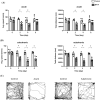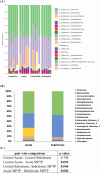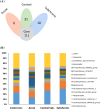Gut Microbial Alteration in MPTP Mouse Model of Parkinson Disease is Administration Regimen Dependent
- PMID: 36708421
- PMCID: PMC9883829
- DOI: 10.1007/s10571-023-01319-7
Gut Microbial Alteration in MPTP Mouse Model of Parkinson Disease is Administration Regimen Dependent
Abstract
Parkinson Disease (PD) is one of the most common neurodegenerative disorders characterized by loss of dopaminergic neurons involved in motor functions. Growing evidence indicates that gut microbiota communicates with the brain known as the gut-brain axis (GBA). Mitochondrial toxin 1-methyl-4-phenyl-1,2,3,6-tetrahydropyridine (MPTP) is commonly used in animal studies to investigate the GBA in PD. Various MPTP administration regimens are performed in PD mouse models involving one to multiple injections in 1 day or one injection per day for several days. The aim of this study is to investigate if the impact of MPTP on gut microbiota differs depending on the administration regimen. C57BL/6 mice were treated with acute or subchronic regimens of MPTP. Motor functions were assessed by open-field, catalepsy, and wire hanging tests. The cecum and the brain samples were obtained for microbiota and gene expression analyses, respectively. MPTP administration regimens differed in their ability to alter the gut microbiota. Firmicutes and Bacteroidota were both increased in subchronic mice while did not change and decreased, respectively, in acute mice. Verrucomicrobiota was elevated in acute MPTP mice but dropped in subchronic MPTP mice. Muribaculaceae was the predominant genus in all groups but acute mice. In acute mice, Akkermansia was increased and Colidextribacter was decreased; however, they showed an opposite trend in subchronic mice. These data suggest that MPTP mouse model cause a gut microbiota dysbiosis in an administration regimen dependent manner, and it is important to take consideration of mouse model to investigate the GBA in neurodegenerative diseases including PD.
Keywords: Acute; Animal model; Microbiota; Subchronic.
© 2023. The Author(s), under exclusive licence to Springer Science+Business Media, LLC, part of Springer Nature.
Conflict of interest statement
The author has no relevant financial or non-financial interests to disclose.
Figures






Similar articles
-
A neurotherapeutic approach with Lacticaseibacillus rhamnosus E9 on gut microbiota and intestinal barrier in MPTP-induced mouse model of Parkinson's disease.Sci Rep. 2024 Jul 4;14(1):15460. doi: 10.1038/s41598-024-65061-w. Sci Rep. 2024. PMID: 38965287 Free PMC article.
-
N-acetyl-L-leucine protects MPTP-treated Parkinson's disease mouse models by suppressing Desulfobacterota via the gut-brain axis.Brain Res Bull. 2023 Oct 1;202:110729. doi: 10.1016/j.brainresbull.2023.110729. Epub 2023 Aug 12. Brain Res Bull. 2023. PMID: 37579888
-
5-HT4 Receptor is Protective for MPTP-induced Parkinson's Disease Mice Via Altering Gastrointestinal Motility or Gut Microbiota.J Neuroimmune Pharmacol. 2023 Dec;18(4):610-627. doi: 10.1007/s11481-023-10085-8. Epub 2023 Oct 2. J Neuroimmune Pharmacol. 2023. PMID: 37782386
-
Optimization of the Preparation Process of Glucuronomannan Oligosaccharides and Their Effects on the Gut Microbiota in MPTP-Induced PD Model Mice.Mar Drugs. 2024 Apr 25;22(5):193. doi: 10.3390/md22050193. Mar Drugs. 2024. PMID: 38786584 Free PMC article.
-
The intranasal administration of 1-methyl-4-phenyl-1,2,3,6-tetrahydropyridine (MPTP): a new rodent model to test palliative and neuroprotective agents for Parkinson's disease.Curr Pharm Des. 2011;17(5):489-507. doi: 10.2174/138161211795164095. Curr Pharm Des. 2011. PMID: 21375482 Review.
Cited by
-
Gut Microbiota-Based Interventions for Parkinson's Disease: Neuroprotective Mechanisms and Current Perspective.Probiotics Antimicrob Proteins. 2025 Jan 15. doi: 10.1007/s12602-024-10433-x. Online ahead of print. Probiotics Antimicrob Proteins. 2025. PMID: 39809955 Review.
-
The contribution of age-related changes in the gut-brain axis to neurological disorders.Gut Microbes. 2024 Jan-Dec;16(1):2302801. doi: 10.1080/19490976.2024.2302801. Epub 2024 Jan 18. Gut Microbes. 2024. PMID: 38237031 Free PMC article. Review.
-
Effects of neural stem cell-derived exosomes on MPTP-induced Parkinson's disease in mice.Naturwissenschaften. 2025 Jul 23;112(4):53. doi: 10.1007/s00114-025-02002-1. Naturwissenschaften. 2025. PMID: 40699331
-
A neurotherapeutic approach with Lacticaseibacillus rhamnosus E9 on gut microbiota and intestinal barrier in MPTP-induced mouse model of Parkinson's disease.Sci Rep. 2024 Jul 4;14(1):15460. doi: 10.1038/s41598-024-65061-w. Sci Rep. 2024. PMID: 38965287 Free PMC article.
-
Modulation of Intestinal Inflammation and Protection of Dopaminergic Neurons in Parkinson's Disease Mice through a Probiotic Formulation Targeting NLRP3 Inflammasome.J Neuroimmune Pharmacol. 2025 Jan 18;20(1):9. doi: 10.1007/s11481-024-10163-5. J Neuroimmune Pharmacol. 2025. PMID: 39826038 Free PMC article.
References
-
- Al Sweidi S, Morissette M, Rouillard C, Di Paolo T (2013) Estrogen receptors and lesion-induced response of striatal dopamine receptors. Neuroscience 236:99–109. 10.1016/j.neuroscience.2012.12.058 - PubMed
-
- Armstrong MJ, Okun MS (2020) Diagnosis and treatment of Parkinson disease: a review. JAMA 323:548–560. 10.1001/jama.2019.22360 - PubMed
MeSH terms
Substances
Grants and funding
LinkOut - more resources
Full Text Sources
Medical

